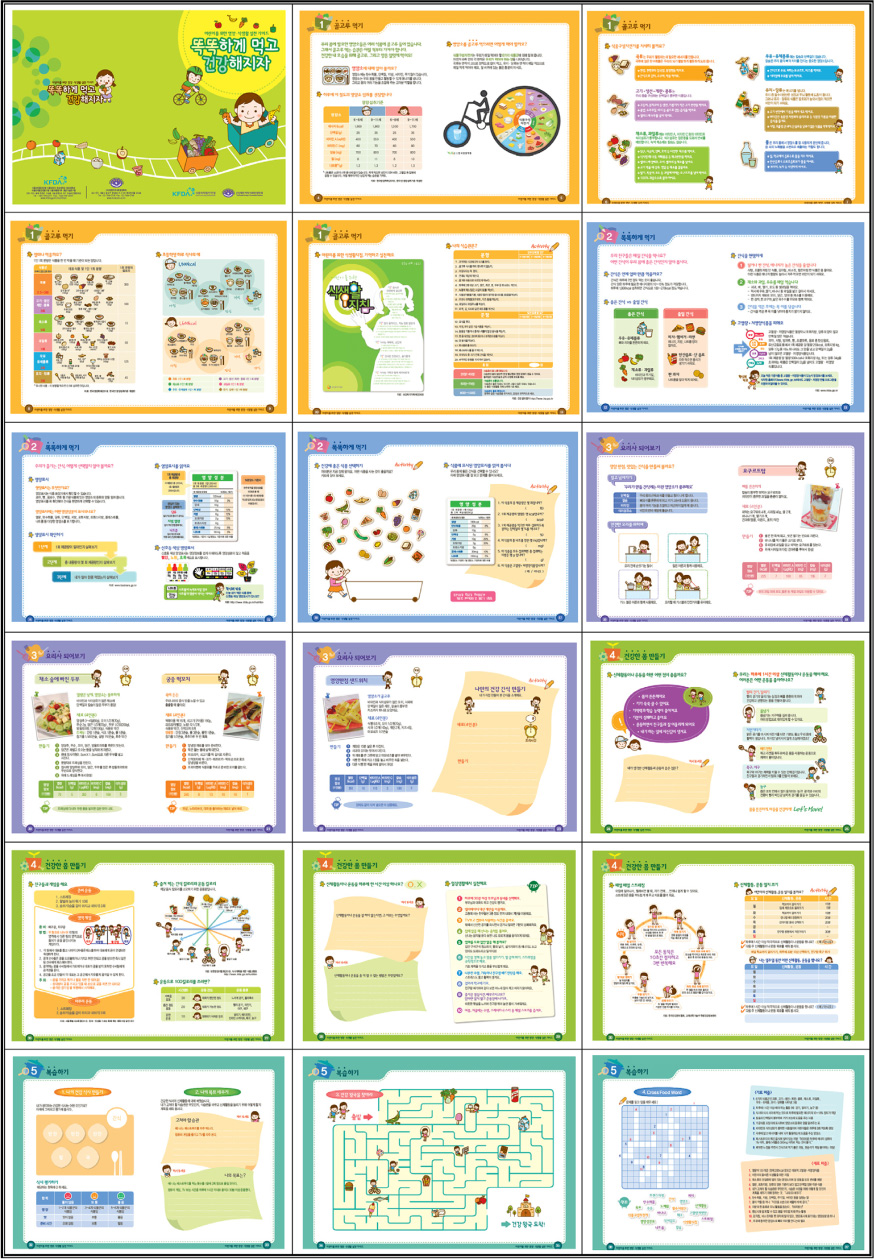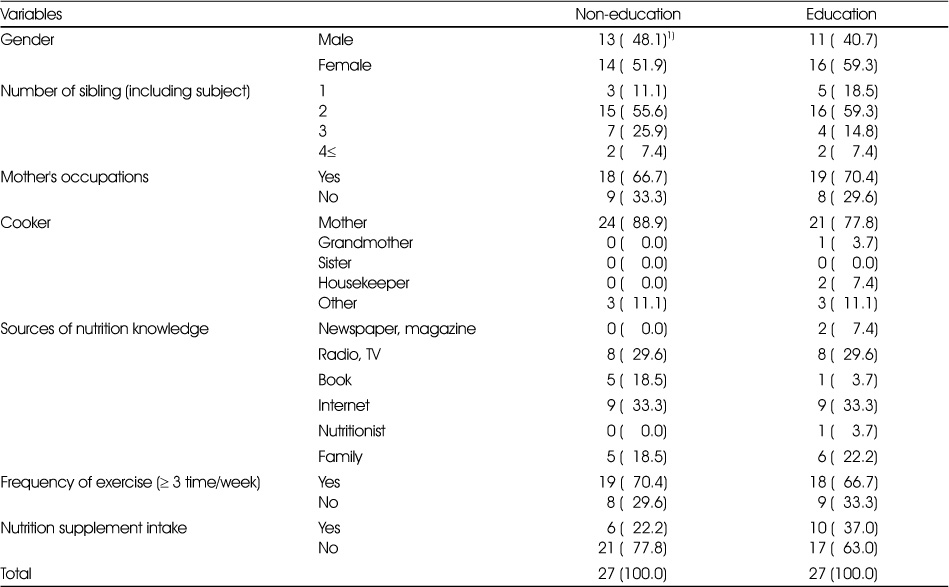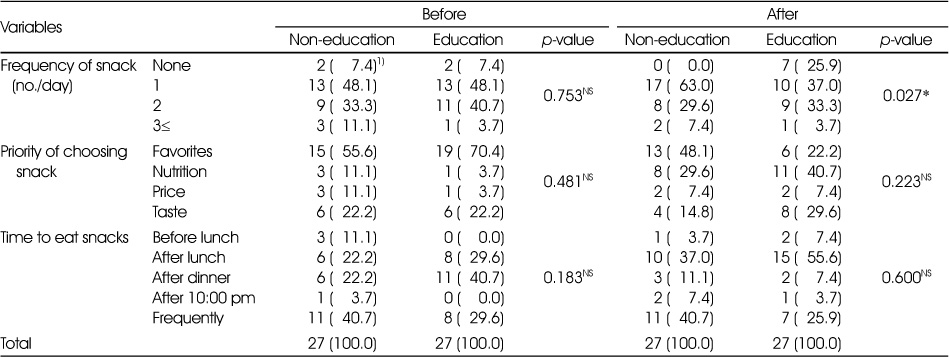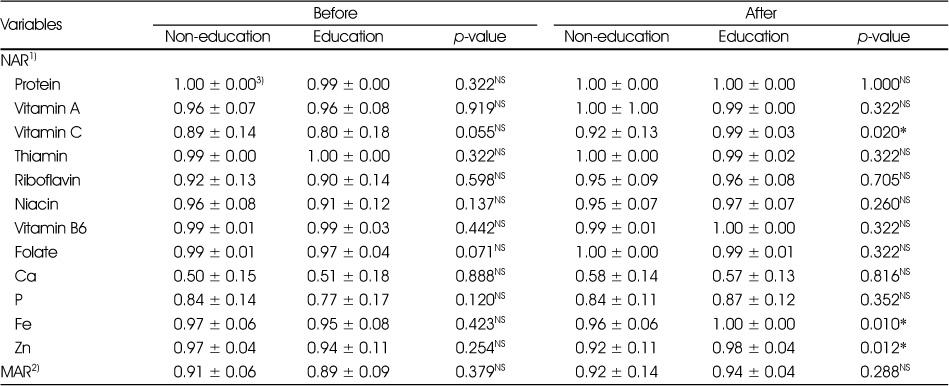Articles
- Page Path
- HOME > Korean J Community Nutr > Volume 23(1); 2018 > Article
-
Research Article
- Effects of Nutrition Education Using Dietary Guidebook in Higher Grade Elementary Students of Jeonbuk Area
-
Mi-Ran Park, Sook-Bae Kim

-
Korean Journal of Community Nutrition 2018;23(1):13-27.
DOI: https://doi.org/10.5720/kjcn.2018.23.1.13
Published online: February 28, 2018
1)Graduate School of Education, Chonbuk National University, Jeonju, Korea.
2)Department of Food Science & Human Nutrition, Research Institute of Human Ecology, Chonbuk National University, Jeonju, Korea.
- Corresponding author: Sook-Bae Kim. Chonbuk National University 567, Baekje-daero, Deokjin-gu, Jeonju 54896, Korea. Tel: (063) 270-3823, Fax: (063) 270-3854, sbkim@jbnu.ac.kr
Copyright © 2018 The Korean Society of Community Nutrition
This is an Open-Access article distributed under the terms of the Creative Commons Attribution Non-Commercial License (http://creativecommons.org/licenses/by-nc/3.0/) which permits unrestricted non-commercial use, distribution, and reproduction in any medium, provided the original work is properly cited.
- 1,105 Views
- 2 Download
- 3 Crossref
Abstract
-
Objectives
- This study was conducted to examine the effects of nutrition education with a dietary guidebook for children on dietary attitude, nutrition knowledge and nutrient intakes.
-
Methods
- The subjects were 54 higher grade elementary students (27 educated vs. 27 non-educated). The educated group was provided individual and/or group lessons (40 min/lesson/week, 4 week) using a dietary guidebook of Children developed by The Korean Society of Community Nutrition (KSCN) & Korean Food and Drug Administration (KFDA). The contents were Balanced Diet, Smart Food Choices, Cooking a Healthy Snack and Building a Healthy Body. We examined the differences in nutrition knowledge, dietary attitudes and dietary intake between the educated group and non-educated group.
-
Results
- After education, the educated group improved dietary attitude, nutrition knowledge and qualitative nutrient intakes compared to the non-educated group. Specifically, among dietary attitudes, ‘taking a meal with salty and spicy food’ increased, while among nutrition knowledge, ‘functions of protein’, ‘functions of fat’, ‘foods with carbohydrates’, ‘foods with fat’, ‘foods with vitamins’, and ‘foods with minerals’ were increased. Nutrition adequacy ratio (NAR) scores for vitamin C, iron, and zinc were increased.
-
Conclusions
- Nutrition education using a dietary guidebook for children developed by the KSCN & KFDA had positive effects on nutrition knowledge and qualitative nutrient intakes. These findings suggest that nutrition education focused on personalized daily energy and nutrient requirements may improve dietary attitude and quantitative nutrient intakes of children.
- 1. Brown JE. Nutrition throughout the life cycle. 4th ed. United States: Cengage learning; 2010. p. 311.
- 2. Koo JO, Lee JW, Choi YS, Kim JH, Lee JH. Life cycle nutrition. Seoul: Hyoilbooks; 2006. p. 229-231.
- 3. Kim OH, Park HA, Cho YG, Kim KW, Hur YI, Song JH. Health status and nutrient intakes of 5th grade elementary students in Seoul and Gyeonggi province. Korean J Community Nutr 2010; 15(6): 717-726.
- 4. Jeong NY, Kim KW. Nutrition knowledge and eating behaviors of elementary school children in Seoul. Korean J Community Nutr 2009; 14(1): 55-66.
- 5. Lee YM. Eating trends in Korean children. Korean J Community Nutr 2006; 11(6): 819-835.
- 6. Kang SA, Lee JW, Kim KE, Koo JO, Park DY. A study of the frequency of food purchase for snacking and its related ecological factors on elementary school children. Korean J Community Nutr 2004; 9(4): 453-463.
- 7. Han HM, Lee SS. A nutrition education program development and the application for the elementary students: Focused on sugar intake education. Korean Assoc Pract Arts Educ 2008; 21(2): 111-131.
- 8. Son SM, Lee KH, Kim KW, Lee YK. The actual nutrition education and counseling. Seoul: Life science; 2010. p. 96-107. p. 189.
- 9. Kim KA, Lee YK. The effect of nutrition education using animations on the nutrition knowledge, eating habits and food preferences of elementary school students. Korean J Community Nutr 2010; 15(1): 50-60.
- 10. Lee JW, Lee HS, Chang NS, Kim JM. The relationship between nutrition knowledge scores and dietary behavior, dietary intakes and anthropometric parameters among primary school children participating in a nutrition education program. Korean J Nutr 2009; 42(4): 338-349.Article
- 11. Cheong HS, Lee HR. A study on the conditions of the nutrition educations and the perceptions of the nutrition teachers and dieticians in the primary and secondary schools in Gyeongnam area. J Basic Sci 2013; 30(1): 41-59.
- 12. Park YH, Kim HH, Shin KH, Shin EK, Bae IS, Lee YK. A survey on practice of nutrition education and perception for implementing nutrition education by nutrition teacher in elementary schools. Korean J Nutr 2006; 39(4): 403-416.
- 13. Her ES, Lee KH. Development of computer-aided nutritional education program for the school children. Korean J Nutr 2002; 35(7): 791-799.
- 14. Ly SY, Kang HK, Yang IS, Kang MH. Analysis of contents of nutrition information on the internet. J Korean Diet Assoc 2004; 10(2): 224-234.
- 15. Lim ES, Cho YS, Kim SN, Kim SB. Development and effects' analysis of nutrition education pamphlet for the higher grades elementary students: focused on individual daily needed Food Exchange Units. Korean J Community Nutr 2012; 17(6): 689-706.Article
- 16. Son MJ, Cho YS, Kim SN, Seo HJ, Kim SB. Development and effects' analysis of nutrition education pamphlet for the lower grades elementary students: Focused on individual daily needed Food Exchange Units. Korean J Community Nutr 2011; 16(6): 647-660.Article
- 17. Kim KA, Lee YK. The effect of nutrition education using animations on the nutrition knowledge, eating habits and food preferences of elementary school students. Korean J Community Nutr 2010; 15(1): 50-60.
- 18. The Korean Nutrition Society. Dietary reference intakes for Koreans. Seoul: Han-Arum Publishing co.; 2015. p. vi-xii. p. 6. p. 53.
- 19. Oh JY, Kim SB. Development and effects analysis of nutrition education program for diabetes mellitus at community health center: focus on individual daily energy requirements and food exchange units. Korean J Community Nutr 2010; 15(4): 485-497.
- 20. Ministry of Food and Drug Safety. Life cycle nutrition management [Internet]. Food safety Korea; 2013; Updated 2015 Aug 24]. cited 2016 May 5]. Available from: http://www.foodsafetykorea.go.kr/portal/board/boardDetail.do.
- 21. Park SH. Effects of nutrition education using smartphone application for elementary school children [master's thesis]. Chonbuk National University; 2014.
- 22. Cho JH, Kim SB, Kim SK, Kim MH, Kim GS, Kim SN. Development of “Children's Food Avatar” Application for Dietary Education. Korean J Community Nutr 2013; 18(4): 299-311.Article
- 23. Hyun T, Yon MY, Kim SH, Kim NH, An SM, Lee SM. Development of a nutrition education website for children. Korean J Community Nutr 2003; 8(3): 259-269.
- 24. Park YS, Lee JW, Seo JS, Lee BK, Lee HS, Lee SK. Nutrition education and counselling. 5th ed. Paju: Kyomunsa; 2014. p. 299-311.
- 25. Lee HL, Lee KE, Ko KS, Hong EA. Relationship between Broca index of late school-aged children and their mothers' eating, cooking, and exercise habit. J Korean Soc Food Sci Nutr 2016; 45(10): 1488-1496.Article
- 26. Lee KA. Activity-based nutrition education for elementary school students. Korean J Nutr 2003; 36(4): 405-417.
- 27. You JS, Kim SM, Chang KJ. Nutritional knowledge and dietary behavior of the 6th grade elementary school students in Daejeon area by gender and skipping breakfast. Korean J Nutr 2009; 42(3): 256-267.Article
- 28. Lim JY, Na HB. Effects of a health education program for elementary school children in Gyeonggi-do rural area. Korean J Community Nutr 2011; 16(1): 1-13.Article
- 29. Jung JY, Choi HS, Lee JS, Kim SY, Park HJ, Kim MO. Nutrition through the life cycle. Seoul: Kwangmoonkag; 2012. p. 161-168.
- 30. Thompson J, Manore M, Vaughan L. The science of nutrition. Boston: Benjamin Cummings; 2010. p. 338. p. 360-376.
- 31. Kim YN, Na HJ. Food sources of thiamin, riboflavin and niacin based on food composition table and national annual food supply data in food balance sheet. Korean J Nutr 2001; 34(7): 809-820.
- 32. Lee YJ, Kim GM, Chang KJ. The analysis of effect on nutrition education of elementary school children, Inchon. J Korean Diet Assoc 2000; 6(2): 86-96.
- 33. Kim MJ. Comparison of food and nutrient intake between weekday and weekend for elementary and middle school students by gender in Busan and some parts of Kyungsang-namdo. J Nutr Health 2013; 46(4): 332-345.Article
- 34. Kim YJ, Choi YJ, Kim HS. Factors related to calceneal broadband ultrasound attenuation, anthropometric indexes and nutrient intakes among elementary school children in Chungnam. Korean J Community Nutr 2013; 18(4): 312-323.Article
- 35. Lee KH, Choi IS, Oh SH. A study on intake/excretion of sodium in Korean children. Korean J Nutr 1995; 28(8): 749-758.
- 36. Heo OS, Oh SH, Shin HS, Kim MR. Mineral and heavy metal contents of salt and salted-fermented shrimp. Food Sci Biotechnol 2005; 37(4): 519-524.
- 37. Shin HH. Dietary sodium intake and cardiovascular diseases. Korean J Community Nutr 2002; 7(3): 391-393.
- 38. Korea Centers for Disease Control and Prevention. Korea Health Statistics 2014: Korea National Health and Nutrition Examination Survey (KNHANES VI-2) [Internet]. Korean Ministry of Health and Welfare; 2014; cited 2016 Dec 20]. Available from: https://knhanes.cdc.go.kr/knhanes/index.do.
- 39. Lee HJ, Lee CH, Lee KS, Jung YJ, Ha SH, Jung YY, et al. Survey on sodium contents in meals of school food service and sodium intakes of students in Busan and Gyeongsangbuk-do. J Korean Soc Food Sci Nutr 2010; 39(1): 85-91.Article
- 40. Kim BR, Cho YE. A study on the evaluation of nutrient intake of middle school students in Kangneung. J Korean Soc Food Sci Nutr 2001; 30(4): 739-746.
REFERENCES
Figure & Data
REFERENCES
Citations

- Developing educational videos to inform rightly about school foodservice from kindergarten to high school: a case study
Gyoungok Gang, Chaewon Park, Haejin Kang, Wan Soo Hong, Yoo Kyoung Park, Sook Hee Choi, Seung Hye Kim, Jieun Choi, Jihyun Park, Hyeja Chang
Korean Journal of Community Nutrition.2024; 29(2): 97. CrossRef - Awareness and Practice of Sugar Reduction in School Foodservice and the Practice of Nutrition Education in Daegu
Suhyang Jang, Kilye Kim, Yeon-Kyung Lee
Korean Journal of Community Nutrition.2021; 26(3): 167. CrossRef - Development of Educational Board Game for Dietary Education; ‘Food-Bicycle’
Jung Hoon Kim
Korean Journal of Human Ecology.2018; 27(5): 411. CrossRef

Fig. 1
Contents and tools of nutrition education
General characteristics of the subjects
1) N (%)
Height, weight and obesity index of the subjects
1) Mean ± S.D
2) Body Mass Index = weight (kg) / height (m2)
< 18.5: under weight, 18.5~22.9: normal, 23~24.9: over weight, ≥25: obese
3) N (%)
NS: Not Significant
Effects on dietary attitudes of the subjects
1) Mean ± S.D
*: p<0.05, **: p<0.01 by t-test
(R) denotes a negatively phrased and reversely scored item
NS: Not Significant
Score: seldom, 1; often, 2; frequent, 3; always, 4
2) by ANCOVA test
Effects on type and frequency of meal and snack
1) N (%)
*: p<0.05 by chi-square test
NS: Not Significant
Effects on nutrition knowledge of the subjects
1) Mean ± S.D
*: p<0.05, **: p<0.01 by t-test
NS: Not Significant
Score: non-corrected, 0; corrected, 1
Effects on energy, protein, and fiber intake of the subjects
1) N (%)
EAR: Estimated Average Requirement
EER: Estimated Energy Requirement
RNI: Recommended Nutrient Intake
AI: Adequate Intake
NS: Not Significant
Effects on vitamin and mineral intake of the subjects
1) N (%), *: p<0.05 by chi-square test
2) by ANCOVA test
EAR: Estimated Average Requirement
RNI: Recommended Nutrient Intake
UL: Tolerable Upper Intake Level
AI: Adequate Intake
Goal: population nutrient intake goal
NS: Not Significan
Effects on NAR and MAR of the subjects
1) NAR: nutrition adequacy ration
2) MAR: mean adequacy ration
3) Mean ± S.D, *: p<0.05 by t-test
NS: Not Significant
1) N (%)
1) Mean ± S.D 2) Body Mass Index = weight (kg) / height (m2) < 18.5: under weight, 18.5~22.9: normal, 23~24.9: over weight, ≥25: obese 3) N (%) NS: Not Significant
1) Mean ± S.D *: p<0.05, **: p<0.01 by (R) denotes a negatively phrased and reversely scored item NS: Not Significant Score: seldom, 1; often, 2; frequent, 3; always, 4 2) by ANCOVA test
1) N (%) *: p<0.05 by chi-square test NS: Not Significant
1) Mean ± S.D *: p<0.05, **: p<0.01 by NS: Not Significant Score: non-corrected, 0; corrected, 1
1) N (%) EAR: Estimated Average Requirement EER: Estimated Energy Requirement RNI: Recommended Nutrient Intake AI: Adequate Intake NS: Not Significant
1) N (%), *: p<0.05 by chi-square test 2) by ANCOVA test EAR: Estimated Average Requirement RNI: Recommended Nutrient Intake UL: Tolerable Upper Intake Level AI: Adequate Intake Goal: population nutrient intake goal NS: Not Significan
1) NAR: nutrition adequacy ration 2) MAR: mean adequacy ration 3) Mean ± S.D, *: p<0.05 by NS: Not Significant

 KSCN
KSCN










 Cite
Cite


